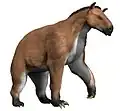| Schizotheriinae Temporal range: Late Eocene to Early Pleistocene | |
|---|---|
 | |
| Moropus elatus at the National Museum of Natural History, Washington, DC | |
| Scientific classification | |
| Domain: | Eukaryota |
| Kingdom: | Animalia |
| Phylum: | Chordata |
| Class: | Mammalia |
| Order: | Perissodactyla |
| Family: | †Chalicotheriidae |
| Subfamily: | †Schizotheriinae Holland and Peterson, 1914[1][2] |
| Genera | |
|
†Ancylotherium | |
Schizotheriines are one of the two subfamilies of the extinct family Chalicotheriidae, a group of herbivorous odd-toed ungulate (perissodactyl) mammals that lived from the Eocene to the Pleistocene. The other clade is the Chalicotheriinae. Both clades had claws rather than hooves on their front feet, an adaptation understood as related to feeding. Schizotheriines also had claws on their hind feet. The fossils of both groups are found in environments that had trees and shrubs. While chalicotheriines developed very derived body forms, schizotheriines remained basically similar in shape to other perissodactyls such as horses and tapirs. Like most forest-dwelling ungulates, they had long necks and forelimbs longer than their hindlimbs. Schizotheriines had longer, higher-crowned cheek teeth than chalicotheriines, which indicates they typically fed on tougher vegetation. The sediments where their fossils are found show they also lived in a wider range of environments, from moist forests to drier woodland or savannah-like environments with trees. Perhaps for this reason, they became more widely distributed than chalicotheriines. Though chalicotheres likely evolved in Asia, schizotheriine fossils are also found in Africa and North America, which they reached by the Bering land bridge. The best-known schizotheriine genus is Moropus. The last survivor of the group was traditionally thought to be Nestoritherium,[3] but it was found to actually be a member of Chalicotheriinae.[4]
Analysis of dental microwear implies that most Miocene Schizotheriinae fed on leaves, fruit, bark and twigs. Their claws were likely used in a hook-like manner to pull down branches to bring these items within reach of the mouth, suggesting they lived as high browsers.[2] Some paleontologists have suggested other uses for the claws, such as stripping bark from trees. Though the claws on the forefeet were long, they could be retracted, so the animals could walk normally on the sole of the foot. The claw-retraction mechanism was unique to schizotheriines, and different from the structure in cats. The broad base of the hind legs may have allowed schizotheriines to rear upright and brace themselves against a tree trunk in order to reach higher for food.[5]
References
- ↑ Holland, W. J.; Peterson, O. A. (1914). "The Osteology of the Chalicotheroidea with Special Reference to a Mounted Skeleton of Moropus elatus Marsh, Now Installed in the Carnegie Museum". Memoirs of the Carnegie Museum. 3 (2): 203–205.
- 1 2 Coombs, Margery C. (13 Feb 2009). "The chalicothere Metaschizotherium bavaricum (Perissodactyla, Chalicotheriidae, Schizotheriinae) from the Miocene (MN5) Lagerstatte of Sandelzhausen (Germany): description, comparison, and paleoecological significance" (PDF). Paläontologische Zeitschrift. Berlin / Heidelberg: Springer. 83 (1): 85–129. doi:10.1007/s12542-009-0004-x. S2CID 140194075.
- ↑ Hooker, J. J.; Dashzeveg, D. (2004). "The origin of chalicotheres (Perissodactyla, Mammalia)". Palaeontology. 47 (6): 1363–1386. doi:10.1111/j.0031-0239.2004.00421.x. ISSN 1475-4983. S2CID 83720739.
- ↑ "New Chalicothere Species Found From the Late Miocene of the Linxia Basin of Gansu, China". Chinese Academy of Sciences. 2012.
- ↑ "Mammoths, Sabertooths, and Hominids - PDF Free Download". epdf.pub. Retrieved 2020-10-10.
Further reading
- Handa, Naoto; Kawabe, Soichiro (2016). "Femur of Schizotheriinae (Perissodactyla, Chalicotheriidae) from the lower Miocene Hiramaki Formation of the Mizunami Group in Gifu Prefecture, central Japan". Journal of Vertebrate Paleontology. 36 (4): e1131163. doi:10.1080/02724634.2016.1131163. S2CID 131390308.
